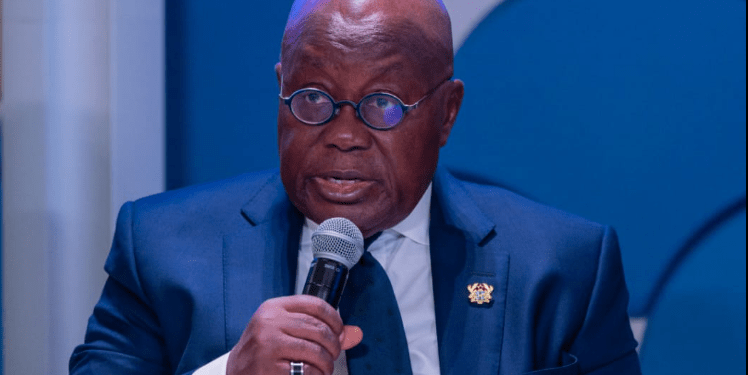President Nana Addo Dankwa Akufo-Addo has bemoaned that Ghana is now playing at the very primary level of owning the resources, and nothing more significant after that.
To that end, he says there’s a need to be deliberate about creating locally-owned major mining companies.
The President said this has on Friday, 3rd May, 2024, when cutting the sod for the construction of the Minerals Income Investment Fund Technical Centre situated on the campus of the George Grant University of Mines and Technology, in Tarkwa.
The Centre will serve as a hub for excellence in mining-related education, research, and innovation, equipping our youth with the knowledge and skills needed to excel in this critical sector and underscoring government’s commitment to developing a robust and sustainable mining industry.
It will be recalled that in 2018, President Akufo-Addo committed to enhancing the potential of Ghana’s mining sector and developing a robust and sustainable mining industry for the benefit of all Ghanaians by ringfencing the royalties and dividends from the mining sector into a Fund.
This informed the passage of the Minerals Income Investment Fund 2018, (Act 978), to gather all dividends from our carried interest in mining, and collect all mineral royalties into the Fund, invest those dividends and royalties for the future gain of all Ghanaians and manage the equity interest of Ghana in mining firms.
Since then, MIIF has transformed itself into one of the fastest growing minerals sovereign funds in the world, with some US$1 billion in assets under management, which is testament to the prudent management of the Fund.
The equity participation and investment by MIIF in Atlantic Lithium, Asante Gold Corporation, and Electrochem Ltd, developing our lithium, gold and salt resources, and in various initiatives such as the proposed, gold backed Exchange Traded Fund to be listed on the Ghana Stock Exchange, and the Small Scale Mining Incubation Programme, which is geared towards formalising the artisanal and small scale gold mining sectors, the Presidents notes, has led to well-structured, mid-tier fully Ghanaian-owned gold mining companies.
“The gold standard of development everywhere in the world is for the indigenous population to participate in ownership, funding, value chain development and other tertiary activities, such as gold trading and listing on the stock markets, amongst others. Sadly, we are now playing at the very primary level of owning the resources, and nothing more significant after that,” the President bemoaned.
That is why, he continued, “we must be deliberate about creating our own major mining companies. It cannot be that we proudly wear the crown as Africa’s number one gold producer, yet we are missing out on the ownership participation space, and in value chain development.”
Touching on Ghana’s gold ownership trajectory, he stated that, “we have learnt to mine gold enough; we have learnt to encourage global firms enough through the provision of management expertise; and we now have to learn to create and grow companies that can also go global. And I see this to be the responsibility of MIIF and all its partners, especially the George Grant University of Mines and Technology.”
“The charge is to develop a symbiotic relationship that leverages the knowledge of the University by the Fund to achieve this end. It is not a matter of whether this is feasible. It is rather a matter of it being done by any means necessary. If you will it, you will find the way.”
He reiterated the Akufo-Addo government’s commitment to develop the relevant ecosystem for firms owned and run by Ghanaians to thrive in the minerals sector, stating that, “our destiny should be written in the wealth that is created and maintained in Ghana, to help accelerate our country’s development.”
He said the MIIF Technical Training Centre, with its state-of-the-art jewellery training centre, will solve the dying art of making jewellery as an important value addition process to gold in the face of challenges with modern, superior craftmanship that have bedevilled the industry.
“Through the construction of this Centre, the expected deliverable is that a new breed of jewellers will be trained here. They will be imbued with the requisite training to become very good jewellers, who will also be trained in how to build businesses, and, equally importantly, who will be given the skills that will ultimately turn Ghana into a jewellery hub for Africa. Any visitor to the country should demand Ghana’s gold jewellery, in the same way our kente has become a referential souvenir for every tourist.”
Scheduled to be completed in eight months, the Centre will have a 500-seater auditorium/lecture hall, a library and offices to support the running of practical programmes in metal smithing, jewellery technology, and hallmarking of jewellery to international standards, whilst exploring artificial intelligence and smart systems in mineral value addition.
He was confident that, the Technical Training Centre will not only benefit the students and faculty of this University but will also contribute to the advancement of the mining industry as a whole and provide cutting-edge training and research facilities, enabling us to stay at the forefront of technological innovation and best practices in mining and mineral processing.


